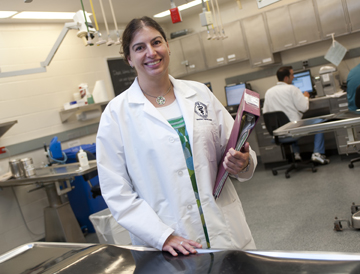Purdue Profiles: Rebecca Packer
September 17, 2012
 |
|
Dr. Rebecca Packer,
associate professor of neurology/neurosurgery in the College of Veterinary
Medicine. (Mark Simons/Purdue University photo) |
To Rebecca Packer, there is beauty in precision -- whether it's plucking pizzicato notes on her violin or removing a malignant tumor from a dog's brain.
An associate professor of neurology and neurosurgery in the College of Veterinary Medicine, Packer is championing new approaches to her field while teaching, seeing patients and sustaining a robust career in the Lafayette Symphony Orchestra.
How did you become interested in veterinary neurology and neurosurgery?
Before I went to veterinary school at North Carolina State University, I completed a master's degree there in zoology with the intention of being a wildlife biologist. At one point, I actually had a job lined up with the U.S. Fish and Wildlife Service to be an endangered species biologist. Eventually, I decided to pursue wildlife medicine instead, because I wanted to be in closer contact with the animals. So I went to vet school.
When I reached my final year of vet school, I did a two-week, clinical neurology rotation as a routine part of my studies, and I just fell in love. I love the inherent problem solving veterinary neurology entails. All cases involve a certain roadmap of nerves, which go from Point A to Point Z in the dogs and cats we see. It's fascinating to study that infrastructure, and it's a fascinating challenge to try to pinpoint where and when problems arise in the neurological system. Every case is like a puzzle.
What sort of neurological research do you conduct?
Our research involves brain tumors. While traditional brain tumor treatments involve resection and chemotherapy or radiation therapy, our research is focusing on developing a host of less-invasive surgical techniques and on reducing side effects.
For example, we have a faculty member working on brain tumor vaccines in collaboration with scientists at the University of Minnesota. We've also been working on nanoparticle delivery for drug therapy, which would allow brain tumor cells to retain drugs better than traditional delivery methods. Nanoparticles also can, in some cases, better penetrate the blood-brain barrier, which is always a problem with traditional drugs.
We hope these techniques will have better outcomes than traditional tumor treatments, particularly because brain tumors are so challenging to treat. We have begun only a limited number of clinical trials on our research thus far, but we're hoping to offer additional treatments in the next few years.
In addition to being a veterinary neurologist and neurosurgeon, you're also an accomplished violinist. How did your interest in music begin?
When I was about 7 years old, I went to a shopping mall with my parents near where I grew up in Canton, Ohio. There, a group of violinists was giving a performance; I saw that and immediately wanted to learn. Eventually, my mom let me start taking lessons.
Growing up, I played in several different regional youth symphonies. When I got to college, I ended up becoming the concertmaster in my college orchestra. I couldn't actually find an orchestra to fit my schedule during my master's work and during vet school, but then as soon as I started my veterinary neurology internship at the University of Georgia, and then my residency at the University of Missouri, I started playing in orchestras in those areas. In 2007, I joined the Lafayette Symphony Orchestra.
So do music and veterinary neuroscience share any similarities?
Both disciplines require extreme organization and commitment -- you need to practice and keep up. I also truly love both disciplines -- I can't live without either.
In general, music is a way for me to balance the stresses of work, and the worry that comes with being a vet. I'm constantly worried about patients and their owners, but when I play music, I find relief from all that.
What are some of your professional goals?
When I arrived at Purdue in 2006, we had no veterinary clinical neurology service. I was the only faculty member, so my goal was to build the program from the ground up. With a lot of help and teamwork on my colleagues' parts, I think we've accomplished that. We now have three faculty members, a robust training program and a strong clinical practice.
So, for me, the next goal is to maintain what we've built, and to maintain the program's reputation as a good place for training and as a good clinical practice, as well as continue to build our brain tumor treatment program. Looking forward, I'm confident that's a goal we'll achieve.
Writer: Amanda Hamon, 49-61325, ahamon@purdue.edu

